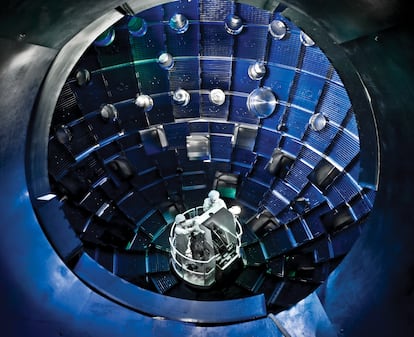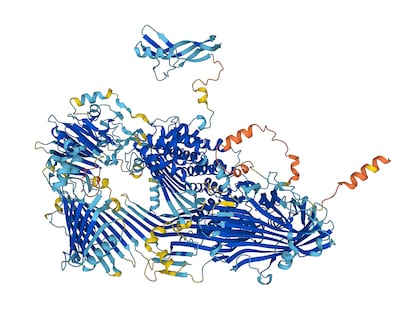US announces ‘history-making’ breakthrough toward endless energy from nuclear fusion
Scientists for the first time achieved a reaction with a net energy gain. Secretary Jennifer Granholm called it one of the most impressive scientific achievements of the 21st century


A team of US scientists has managed to successfully produce a nuclear fusion reaction capable of generating a net energy gain. The results of this “major scientific breakthrough,” carried out at a federal facility in California, were presented on Tuesday amid enormous expectation by Secretary of Energy Jennifer Granholm at a news conference in Washington DC.
With this milestone, the US government hopes to move a step closer to the dream of developing a source of clean, cheap and potentially inexhaustible energy. At the “history-making announcement,” Granholm described it as “one of the most impressive scientific achievements of the 21st century” and asserted that “this day will end up in the history books.”
BREAKING NEWS: This is an announcement that has been decades in the making.
— U.S. Department of Energy (@ENERGY) December 13, 2022
On December 5, 2022 a team from DOE's @Livermore_Lab made history by achieving fusion ignition.
This breakthrough will change the future of clean power and America’s national defense forever. pic.twitter.com/hFHWbmCNQJ
The researchers achieved a small reaction that provides more energy than it consumes. The experiments were carried out at the Lawrence Livermore National Laboratory, which houses the National Ignition Facility (NIF). Inaugurated in 2009, it uses the world’s largest laser which, directed at a tiny ball of hydrogen plasma, generates conditions that imitate the explosions of nuclear weapons.
The great challenge for generating energy through fusion lies in the end amount being greater than the energy invested in the effort to trigger the atomic reaction. In this case, the gain was 50%.
The results were obtained on December 5, when 192 laser beams were focused on a spot the size of a popcorn, fleetingly generating the conditions of a three-million-degree-Celsius star, explained Jill Hruby, Under Secretary for Nuclear Security at the Department of Energy (DOE).
The implications of this discovery, which was first reported on by the Financial Times on Sunday, remain to be fully determined, but according to Granholm they represent a great step on the road to the creation of unlimited power without carbon emissions. “This historic, first-of-its kind achievement [...] will provide invaluable insights into the prospects of clean fusion energy, which would be a game-changer for efforts to achieve President Biden’s goal of a net-zero carbon economy,” said the DOE in a statement.
It will also make it easier for the United States to maintain a nuclear deterrent without nuclear testing, said the DOE. That was the primary goal for which the NIF was built, at a cost of $3.5 billion.

For the better part of the last century, science has spent billions trying to emulate the process that powers the Sun in order to generate a virtually endless source of energy that produces no greenhouse gases and no dangerous radioactive waste that takes a very long time to process, as is the case with nuclear power plants. This source of electricity also offers advantages over wind and solar energy, as it requires fewer resources.
Rumors were rife on Monday among physicists and other scientists studying nuclear fusion. For them, carbon-free energy is a “holy grail” that they have fantasized about since the 1950s, when the Lawrence Livermore Laboratory was founded. During all this time, they had only been able to create fusion reactions that consumed more energy than they were capable of producing.
It might still be decades before the new achievement can be put to a commercial use, but the Biden Administration has not missed the opportunity to present it as a landmark for US science.
On Dec. 5, 2022, a team at LLNL's @lasers_llnl conducted the first controlled fusion experiment in history to achieve fusion ignition. Also known as scientific energy breakeven, the experiment produced more energy from fusion than the laser energy used to drive it. pic.twitter.com/t9htICEcuh
— Lawrence Livermore National Laboratory (@Livermore_Lab) December 13, 2022
Fusion is achieved when two nuclei combine to form a new one, in a process that occurs naturally in the Sun and other stars. To achieve this on Earth, it is necessary to generate and maintain a plasma, a gas whose very high temperature creates an environment in which electrons are released from atomic nuclei. Energy is released because the mass of the bound nucleus is less than the mass of its component protons and neutrons; this deficit is converted into energy through the most famous equation in the history of physics, formulated by Einstein: E=mc².
At present, different projects are pursuing this goal of unlimited energy through nuclear fusion. In February, UK researchers announced that they had more than doubled the previous record for the generation and sustainment of nuclear fusion. They did this in a huge donut-shaped machine equipped with gigantic magnets called a tokamak. They generated a record amount of sustained power. Unfortunately it only lasted five seconds. The most relevant project in Europe, the ITER in France, has plans to apply its findings to the real-world electricity grid in the medium term.
Sign up for our weekly newsletter to get more English-language news coverage from EL PAÍS USA Edition
Tu suscripción se está usando en otro dispositivo
¿Quieres añadir otro usuario a tu suscripción?
Si continúas leyendo en este dispositivo, no se podrá leer en el otro.
FlechaTu suscripción se está usando en otro dispositivo y solo puedes acceder a EL PAÍS desde un dispositivo a la vez.
Si quieres compartir tu cuenta, cambia tu suscripción a la modalidad Premium, así podrás añadir otro usuario. Cada uno accederá con su propia cuenta de email, lo que os permitirá personalizar vuestra experiencia en EL PAÍS.
¿Tienes una suscripción de empresa? Accede aquí para contratar más cuentas.
En el caso de no saber quién está usando tu cuenta, te recomendamos cambiar tu contraseña aquí.
Si decides continuar compartiendo tu cuenta, este mensaje se mostrará en tu dispositivo y en el de la otra persona que está usando tu cuenta de forma indefinida, afectando a tu experiencia de lectura. Puedes consultar aquí los términos y condiciones de la suscripción digital.









































